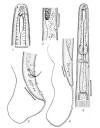- Small, slender nematodes.
- Cuticle thin, with fine transverse striation and 24-26 longitudinal
ridges.
- Anterior end of body tapering. Head flattened anteriorly.
- Lips absent. Six short setiform papillae surround oral opening.
- Stoma narrow, 2.1-2.2 times as long as head width. Cheilostom with
12 strongly cuticu-larized curved ribs. Gymnostom in shape of wide ring.
Stegostom with large, mobile, claw-like dorsal tooth, its apical end
bifurcated.
- Right subventral denticle small, thin. In left subventral position
teeth and denticles absent. Stegostom in shape of long cylinder, 1.3-1.5
times as long as its anterior part.
- Amphid openings small, ellipsoidal, situated at the level of dorsal
tooth.
- Esophagus slender, sharply divided into two sections: anterior
muscular section and posterior glandular section. Anterior part of
esophagus 1.4-1.6 times as long as its posterior section.
- Excretory pore situated posterior to nerve ring.
- Cardia narrow, muscular.
- Rectum 1.3-1.7 times as long as anal body diameter.
- Tail long, strongly tapering at base, thereupon thin and filiform.
Reported median body size for this species (Length mm; width micrometers; weight micrograms) - Click:
|
 |
|
Glauxinema aquaticum (from Gagarin and Thanh, 2006) |
Females:
- Gonads didelphic, amphidelphic; ovaries antidromous. Ovarial bend
long, almost reaching vulva.
- Vulva preequatorial, in the shape of ellipsoidal slit.
- Vulval lips not cuticularized, not protruded.
- Vagina short.
- Uterus containing one or two eggs, measuring 45-53 × 20-23 μm.
|
|
Males:
- General appearance similar to that of female, size smaller.
- Cuticle thin, with fine transverse striation and 24-26 longitudinal
ridges.
- Head with four supplementary setae about 1.0- 1.2 μm long situated
posterior to six labial setiform papillae.
- Structure of stoma and esophagus similar to those of female.
- Amphid openings in the shape of small transverse ellipse situated at
the level of dorsal tooth.
- Testis simple.
- Spicules slender, ventrally curved, with rounded capituli; their
apices pointed. Spicules 1.5 times as long as cloacal body diameter.
- Gubernaculum 2.3-2.5 times shorter than spicules.
- Ten pairs of sexual setiform papillae: 3 pairs precloacal and 7
pairs postcloacal (caudal).
- Bursa rudimentary
from Gagarin and Thanh, 2006
|
Aquatic environments; reported from the Day River in Vietnam.
Gagarin, V.G. & Nguyen Vu Thanh. 2006. Re-classification of
Neodiplogasteridae with notes on the genus Glauxinema Allgen, 1947 and
description of G. aquaticum sp. n. from Vietnam (Nematoda). Zoosystematica
Rossica, 15:1-6.